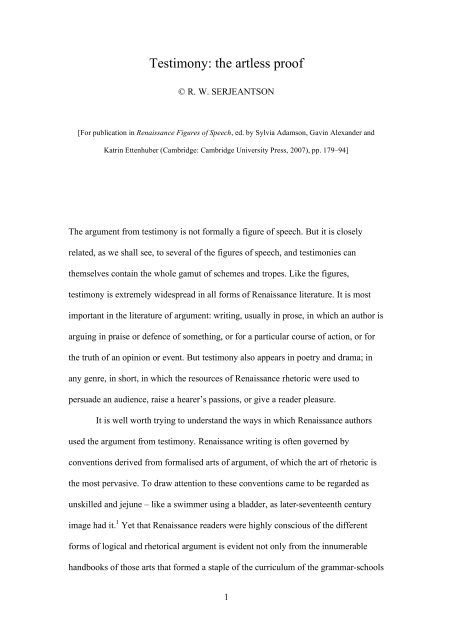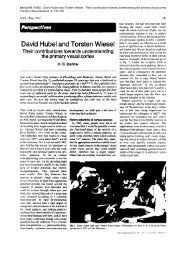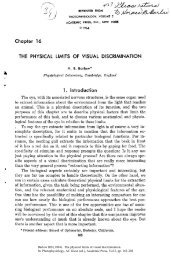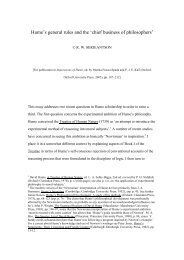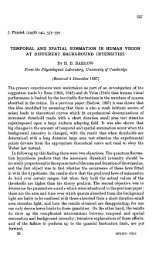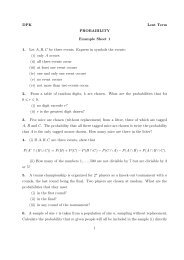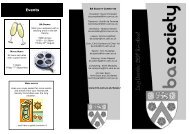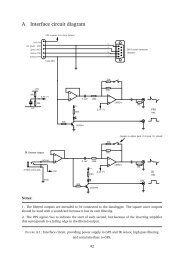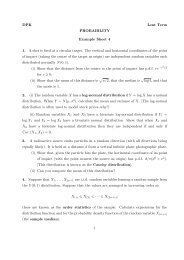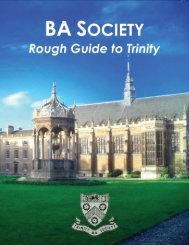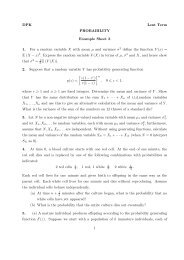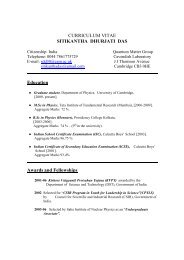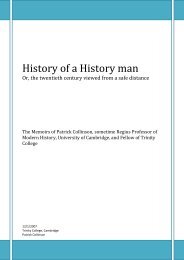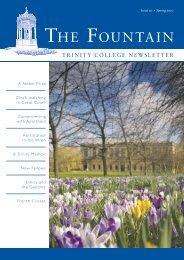Testimony - the artless proof - Trinity College
Testimony - the artless proof - Trinity College
Testimony - the artless proof - Trinity College
You also want an ePaper? Increase the reach of your titles
YUMPU automatically turns print PDFs into web optimized ePapers that Google loves.
<strong>Testimony</strong>: <strong>the</strong> <strong>artless</strong> <strong>proof</strong><br />
© R. W. SERJEANTSON<br />
[For publication in Renaissance Figures of Speech, ed. by Sylvia Adamson, Gavin Alexander and<br />
Katrin Ettenhuber (Cambridge: Cambridge University Press, 2007), pp. 179–94]<br />
The argument from testimony is not formally a figure of speech. But it is closely<br />
related, as we shall see, to several of <strong>the</strong> figures of speech, and testimonies can<br />
<strong>the</strong>mselves contain <strong>the</strong> whole gamut of schemes and tropes. Like <strong>the</strong> figures,<br />
testimony is extremely widespread in all forms of Renaissance literature. It is most<br />
important in <strong>the</strong> literature of argument: writing, usually in prose, in which an author is<br />
arguing in praise or defence of something, or for a particular course of action, or for<br />
<strong>the</strong> truth of an opinion or event. But testimony also appears in poetry and drama; in<br />
any genre, in short, in which <strong>the</strong> resources of Renaissance rhetoric were used to<br />
persuade an audience, raise a hearer’s passions, or give a reader pleasure.<br />
It is well worth trying to understand <strong>the</strong> ways in which Renaissance authors<br />
used <strong>the</strong> argument from testimony. Renaissance writing is often governed by<br />
conventions derived from formalised arts of argument, of which <strong>the</strong> art of rhetoric is<br />
<strong>the</strong> most pervasive. To draw attention to <strong>the</strong>se conventions came to be regarded as<br />
unskilled and jejune – like a swimmer using a bladder, as later-seventeenth century<br />
image had it. 1 Yet that Renaissance readers were highly conscious of <strong>the</strong> different<br />
forms of logical and rhetorical argument is evident not only from <strong>the</strong> innumerable<br />
handbooks of those arts that formed a staple of <strong>the</strong> curriculum of <strong>the</strong> grammar-schools<br />
1
and <strong>the</strong> early years of a university education, but also from <strong>the</strong> printed and manuscript<br />
analyses that survive of classical, biblical, and vernacular literature. William<br />
Temple’s analysis of Sir Philip Sidney’s Apology for Poetry, for instance, paid careful<br />
attention to Sidney’s use of testimony. 2 To understand <strong>the</strong> arguments Renaissance<br />
authors used, <strong>the</strong>n, may deepen our appreciation of <strong>the</strong> effects <strong>the</strong>y hoped to bring<br />
about in <strong>the</strong>ir audiences, and also, perhaps, enable us to conjecture how that audience<br />
might have taken <strong>the</strong>m.<br />
To this end, I begin by exploring <strong>the</strong> <strong>the</strong>ories of testimony that flourished in<br />
<strong>the</strong> sixteenth and seventeenth centuries. I <strong>the</strong>n turn to consider how testimonies were<br />
presented and amplified, before considering <strong>the</strong> relationship between testimony and<br />
<strong>the</strong> figures of speech. An account of one of <strong>the</strong> central uses of Renaissance testimony<br />
– to establish <strong>the</strong> ‘true value’ of something – is followed by some closing suggestions<br />
about <strong>the</strong> changing fortunes of testimony in <strong>the</strong> course of <strong>the</strong> seventeenth century.<br />
I. THEORIES OF TESTIMONY<br />
Renaissance rhetoricians, following <strong>the</strong> Latin orator and rhetorical <strong>the</strong>orist Cicero,<br />
commonly divided <strong>the</strong> art of rhetoric into five ‘parts’: invention (inventio),<br />
arrangement (dispositio), style (elocutio), memory (memoria), and delivery<br />
(pronuntiatio). 3 The figures of speech fell within <strong>the</strong> province of style. <strong>Testimony</strong>,<br />
however, was not a figure of speech but a form of argument, and <strong>the</strong> part of rhetoric<br />
that considered arguments was not style, but invention – <strong>the</strong> ‘most important part of<br />
all’ according to Cicero. 4 Yet most Renaissance writers on rhetoric emphasised <strong>the</strong><br />
congruence of inventio and elocutio, regarding <strong>the</strong>m as parallel means to <strong>the</strong> same<br />
2
end: invention ‘discovered’ <strong>the</strong> subject-matter (<strong>the</strong> res) of an argument, whilst<br />
elocutio amplified and varied its words (verba).<br />
Invention, <strong>the</strong> art of finding out arguments, had a slightly unusual status. It fell<br />
into <strong>the</strong> province not only of rhetoric, but also of <strong>the</strong> o<strong>the</strong>r Renaissance discipline of<br />
argument, rhetoric’s more abstract and rigorous sister art: logic. Logic (or dialectic:<br />
<strong>the</strong> two terms are more or less synonymous in English in this period) was regarded by<br />
some influential <strong>the</strong>orists as having two principal parts: invention (inventio), and<br />
judgement (judicium; <strong>the</strong> assessment of arguments). This tendency was initially<br />
inaugurated by <strong>the</strong> Italian humanist Lorenzo Valla (c.1406-1457), whose Dialectical<br />
Disputations were heavily indebted to <strong>the</strong> Roman rhetorician Quintilian’s (AD 35-95)<br />
Education of <strong>the</strong> Orator. 5 Valla’s ideas were developed by <strong>the</strong> Friesian humanist<br />
Rudolph Agricola (1443-1485) in his On Dialectical Invention, a work which became<br />
extremely influential in earlier sixteenth century Europe after being championed by<br />
<strong>the</strong> most important of all <strong>the</strong> nor<strong>the</strong>rn humanists, Desiderius Erasmus (1466/69-<br />
1536). 6 But perhaps <strong>the</strong> most decisive author on <strong>the</strong> subject was <strong>the</strong> controversial<br />
<strong>the</strong>orist of <strong>the</strong> liberal arts, Petrus Ramus (1515-1572). Ramus insisted that rhetoric<br />
and dialectic were unnecessarily confused. His solution was to apportion invention<br />
and arrangement or judicium to dialectic, and to assert that a proper attention to<br />
‘method’ (methodus) would render <strong>the</strong> art of memory needless. Hence all that Ramus<br />
and his follower Omer Talon allowed to rhetoric was pronuntiatio and (most<br />
importantly) elocutio, <strong>the</strong> doctrine of <strong>the</strong> figures and tropes. 7<br />
Some Renaissance <strong>the</strong>orists of argument, and particularly <strong>the</strong> Ramists,<br />
<strong>the</strong>refore made testimony exclusively a part of logic, whilst o<strong>the</strong>rs allowed that it<br />
(also) belonged to rhetoric. But all agreed that, in technical terms, testimony was one<br />
of <strong>the</strong> ‘topics’ or ‘common-places’ (loci communes) of argumentative invention.<br />
3
These ‘topics’ had a formal and well-defined sense, from which <strong>the</strong> more general and<br />
less precise modern use of <strong>the</strong> word derives. They were conceived as ‘seats of<br />
argument’: places, as it were, to which <strong>the</strong> orator might go to find or ‘discover’<br />
(invenire) material for an oration. In <strong>the</strong> Renaissance <strong>the</strong>y formed a vital<br />
argumentative resource. Their purpose was to help speakers win credit for <strong>the</strong>ir<br />
arguments: in a very widely quoted definition, Cicero had defined an argument as a<br />
‘plausible invention to produce belief’ (probabile inventum ad faciendam fidem). 8<br />
The topics of logic (to begin with <strong>the</strong>m) tended to be strongly abstract and<br />
comparative in nature. As Thomas Wilson put it in his popular vernacular Arte of<br />
Rhetorique (1553), <strong>the</strong> logician ‘talketh of things universally, without respect of<br />
person, time, or place.’ 9 The assumptions that informed <strong>the</strong> logical topics were often<br />
those of neo-Aristotelian philosophy, which emphasised relations between cause and<br />
effect, which regarded <strong>the</strong> world as being ordered according to a hierarchy of genera<br />
and species, and which prized syllogistic argument founded upon essential definitions<br />
of things. Hence <strong>the</strong> places from which logicians were instructed to draw <strong>the</strong>ir<br />
arguments included such topics as definition, cause, effect, contraries, <strong>the</strong> greater, and<br />
<strong>the</strong> less. 10 King Lear’s warning to Cordelia that ‘nothing will come of nothing’ may<br />
be regarded as an argument drawn from <strong>the</strong> topic of <strong>the</strong> cause (as well as being a<br />
vernacular rendering of <strong>the</strong> philosophical maxim ex nihilo nihil fit). Similarly,<br />
Brutus’s answer for his actions in Julius Caesar – ‘not that I loved Caesar less, but<br />
that I loved Rome more’ – is (among o<strong>the</strong>r things) an instance of argument from <strong>the</strong><br />
topic of <strong>the</strong> greater. 11<br />
The rhetorical ‘topics’, by contrast, were much more specific and<br />
circumstantial in nature. Rhetoricians were warned of <strong>the</strong> ‘folly’ of not taking into<br />
account <strong>the</strong> time and place of <strong>the</strong>ir speeches, and <strong>the</strong> audiences to whom <strong>the</strong>y were<br />
4
delivered. 12 They might <strong>the</strong>refore seek arguments from <strong>the</strong> more moral and human<br />
topics of honesty, possibility, greatness and pettiness; or consider <strong>the</strong> ‘circumstances’<br />
of an action – who, what, when, where, why, with what help. 13 In a demonstrative<br />
oration praising a person, for instance, <strong>the</strong> orator was encouraged draw material from<br />
<strong>the</strong> topics of <strong>the</strong>ir birth or death, <strong>the</strong> kingdom or town in which <strong>the</strong>y lived, and <strong>the</strong>ir<br />
parents and ancestors. 14<br />
In both <strong>the</strong> arts of logic and rhetoric, <strong>the</strong>n, testimony served as one fur<strong>the</strong>r<br />
‘place’ to which speakers might go to in order to find material for <strong>the</strong>ir arguments. In<br />
<strong>the</strong> same way that a logician might draw material from causes or effects, and a<br />
rhetorician might draw material from <strong>the</strong> justice or injustice of a particular cause, so<br />
both forms of argument appealed to <strong>the</strong> topic of testimony to find fur<strong>the</strong>r material for<br />
<strong>the</strong>ir speeches. For logicians, testimonies could provide a source of propositions for<br />
syllogisms or enthymemes, whilst for rhetoricians testimonies were a fur<strong>the</strong>r and<br />
important means of means of imparting credit (fides) to <strong>the</strong>ir arguments. 15<br />
An exemplary genre – <strong>the</strong> funeral oration – suggests some of <strong>the</strong> uses of <strong>the</strong><br />
topic of testimony in practice. 16 In this genre it serves as a particularly valuable source<br />
of praise; one deployed by John Donne, for instance, in <strong>the</strong> sermon he preached at <strong>the</strong><br />
funeral of Sir William Cokayne on 12 December 1626. Donne’s witness here is none<br />
o<strong>the</strong>r than king James I, himself very recently deceased. Donne writes that he had<br />
‘sometimes heard’ James ‘say of’ Cokayne, ‘That he never heard any man of his<br />
breeding, handle businesses more rationally, more pertinently, more elegantly, more<br />
perswasively.’ 17 This conventionally laudatory function of testimony could be<br />
exploited in more self-consciously original ways; above all, perhaps, in <strong>the</strong> speech<br />
Antony gives to <strong>the</strong> plebeians over Caesar’s body in Shakespeare’s Julius Caesar<br />
(1599). Here Antony deftly turns around <strong>the</strong> convention of citing testimonies to <strong>the</strong><br />
5
deceased when he sets all his reasons for Caesar’s virtuous nature – his fidelity, his<br />
justice, his military success, and his refusal of <strong>the</strong> ‘kingly crown’ – against Brutus’s<br />
opposing testimony: ‘Yet Brutus says he was ambitious’. 18 The disjunction between<br />
what Brutus says and <strong>the</strong> expected conventions of <strong>the</strong> funeral genre highlights <strong>the</strong><br />
falseness of Brutus’s position and begins <strong>the</strong> rhetorical work of turning Antony’s<br />
audience against Caesar’s assassins.<br />
Yet <strong>the</strong>re was one way in which testimony was regarded as being a slightly<br />
unusual form of argument: in contrast to <strong>the</strong> o<strong>the</strong>r topical arguments, <strong>the</strong> kind of <strong>proof</strong><br />
it provided was ‘regarded as <strong>artless</strong>’. (‘Art’, in this context, implies ‘skill’ or<br />
‘technique’, ra<strong>the</strong>r than imaginative inspiration; rhetoric was conceived as an ars, a<br />
set of practical skills, ra<strong>the</strong>r than a scientia, or body of knowledge.) In its formal<br />
classification, <strong>the</strong> <strong>the</strong>orists suggested no particular skill was necessarily required to<br />
discover or ‘invent’ testimonies, because <strong>the</strong>y already existed. For this reason<br />
Aristotle, in his Art of Rhetoric, had called <strong>the</strong>se sorts of <strong>proof</strong> atechnoi, ‘without art’,<br />
and Quintilian, following Aristotle closely here, had coined <strong>the</strong> Latin term<br />
inartificialis. 19 Following <strong>the</strong>se authors, Renaissance rhetoricians commonly<br />
classified judgements, rumours, fame, information obtained by torture, oaths, and<br />
testimonies all as ‘<strong>artless</strong>’ <strong>proof</strong>s. 20 Of <strong>the</strong>se, testimonies were <strong>the</strong> most general and,<br />
for Renaissance authors, <strong>the</strong> most useful. Moreover, as we shall go on to see, although<br />
<strong>the</strong>se <strong>proof</strong>s were formally classified as ‘<strong>artless</strong>’, in practice a large body of precepts<br />
grew up about how to use and present <strong>the</strong>m.<br />
Quintilian’s term inartificialis was picked up very widely in <strong>the</strong> sixteenth<br />
century, owing above all to its adoption by Petrus Ramus in his influential Dialectic<br />
(1556). 21 Ramus was a high-profile French convert to Protestantism, who had <strong>the</strong><br />
misfortune to be murdered in <strong>the</strong> course of <strong>the</strong> St Bartholomew’s Day massacre of<br />
6
1572, in which a large number of Huguenots were slaughtered by <strong>the</strong>ir fellow Roman<br />
Catholic citizens. This shocking event became immediately notorious among<br />
European protestants. Christopher Marlowe’s play The Massacre at Paris (1593)<br />
dramatises it, and towards <strong>the</strong> beginning of <strong>the</strong> play Marlowe actually depicts<br />
Ramus’s murder at <strong>the</strong> hands of <strong>the</strong> dukes of Guise and Anjou. 22 Guise is represented<br />
as taunting Ramus for some of <strong>the</strong> things for which he was most notorious: his<br />
shallow learning, his tendency to analyse any subject-matter by means of<br />
dichotomies, and his fondness for epitomes. Most strikingly, Guise <strong>the</strong>n goes on to<br />
mock Ramus’s account of testimony:<br />
And he forsooth must goe and preach in Germany:<br />
Excepting against Doctors axioms,<br />
And ipse dixit with this quidditie,<br />
Argumentum testimonii est inartificiale<br />
[‘argument from testimony is <strong>artless</strong>’].<br />
To contradict which, I say, Ramus shall dye:<br />
How answere you that? your nego argumentum [‘I deny <strong>the</strong> argument’]<br />
Cannot serve, sirra, kill him. 23<br />
This scene, characteristically for Marlowe, is a learned joke. Guise’s speech is a<br />
parody of <strong>the</strong> genre of <strong>the</strong> philosophical disputation, with its formal procedures of<br />
proposition and counter-argument; it also has <strong>the</strong> disputation’s self-consciousness<br />
about <strong>the</strong> arguments being employed. Moreover, in his account of inartificial<br />
argument, Ramus had described it as having ‘but little streng<strong>the</strong> to prove or disprove’<br />
(perexiguam vim probationis). 24 This characterisation of <strong>the</strong> argument from authority<br />
7
underlies Guise’s charge that Ramus is hostile to ‘Doctors axioms’ and <strong>the</strong>ir<br />
authoritative pronouncements; ipse dixit (‘he himself said so’) was <strong>the</strong> expression<br />
disciples of <strong>the</strong> Greek philosopher Pythagoras conventionally used to introduce <strong>the</strong>ir<br />
master’s words. 25 Guise’s ‘I say’, fur<strong>the</strong>rmore, is a mocking parody of <strong>the</strong> ipse dixit<br />
formula. Overall, <strong>the</strong> passage is a prime case of a literary text working in dynamic<br />
relation to <strong>the</strong> rhetorical instrument it is employing. It is also, in <strong>the</strong> end, a piece of<br />
dark wit about <strong>the</strong> inefficacy of verbal argument in <strong>the</strong> face of physical violence. 26<br />
<strong>Testimony</strong>, <strong>the</strong>n, was one of <strong>the</strong> topics of rational and oratorical invention. At<br />
one level its relationship to o<strong>the</strong>r arguments corresponds to <strong>the</strong> well-established<br />
distinction in medieval philosophical and <strong>the</strong>ological discourse between reason (ratio)<br />
and authority (auctoritas). Yet it would be misleading to suggest that <strong>the</strong> distinction<br />
was as sharply drawn as this in <strong>the</strong> Renaissance. Precisely because of <strong>the</strong> profound<br />
impact in this period of neo-classical rhetoric – <strong>the</strong> reach of which even extended (via<br />
<strong>the</strong> tradition of humanist dialectic) to <strong>the</strong> discipline of logic – forms of Renaissance<br />
argument, including Renaissance philosophy, are less inclined to draw this distinction<br />
between reason and authority rigorously, tending ra<strong>the</strong>r to be more self-consciously<br />
eloquent, and also more inclined to draw upon historical and poetic resources, than<br />
<strong>the</strong>ir late medieval precursors. They were also, as we shall now see, extremely self-<br />
conscious about how testimonies should be presented and amplified.<br />
II. PRESENTING TESTIMONY<br />
For all that its ‘<strong>artless</strong>’ nature made testimony a slightly unusual form of argument, it<br />
had one fundamental use: to prove a point. In this sense, testimony functioned ra<strong>the</strong>r<br />
8
like a witness in a law-court. There is nothing surprising about this: <strong>the</strong> classical<br />
<strong>the</strong>ories of oratory from which Renaissance rhetoric developed were written above all<br />
for <strong>the</strong> benefit of pleaders in law-courts and popular political orators. 27 Hence it<br />
would be a mistake to conclude that simply because <strong>the</strong>y classified testimony as an<br />
‘<strong>artless</strong>’ <strong>proof</strong> <strong>the</strong> rhetorical <strong>the</strong>orists of antiquity or <strong>the</strong>ir Renaissance heirs regarded<br />
it as unimportant. Quintilian, in fact, had even gone so far as to say that <strong>the</strong> greatest<br />
part of legal cases were made up of inartificial <strong>proof</strong>s, and he went on to assert that<br />
although <strong>the</strong>se inartificial <strong>proof</strong>s lacked art in <strong>the</strong>mselves, never<strong>the</strong>less ‘<strong>the</strong> highest<br />
powers of eloquence are generally required to uphold or refute <strong>the</strong>m’ (et adlevanda ...<br />
et refellenda). 28<br />
Yet for a Renaissance philosopher, and much more so for an orator or a poet,<br />
it was usually not enough simply to cite a testimony like a witness to <strong>the</strong> bar. As<br />
Renaissance rhetoric became increasingly directed towards written ra<strong>the</strong>r than oral<br />
art, <strong>the</strong> precepts that Roman orators had formulated for <strong>the</strong> treatment of witnesses<br />
came to be applied to <strong>the</strong> use of more literary and philosophical testimony. One<br />
important consequence of this was that <strong>the</strong> manuals on good Latin style that<br />
proliferated in <strong>the</strong> Renaissance commonly devoted space to teaching <strong>the</strong>ir readers<br />
how to ‘bring in’ (citare) textual witnesses in an elegant and classically sanctioned<br />
manner. 29 The godfa<strong>the</strong>r of all <strong>the</strong>se works was Lorenzo Valla’s Elegancies of <strong>the</strong><br />
Latin Language (1444); its worthy successor was Desiderius Erasmus’s On <strong>the</strong><br />
Twofold Abundance of Words and Things (1512). Erasmus’ book is celebrated among<br />
scholars of humanism for giving a hundred-and-forty-six different variations on <strong>the</strong><br />
phrase ‘your letter pleased me greatly’, but Erasmus is scarcely less copious on <strong>the</strong><br />
subject of how to introduce authorities, as this extract suggests:<br />
9
As Cicero has it (ut Ciceroni placet); on Plato’s authority (auctore Platone);<br />
as Varro bears witness (teste Varrone); if we accept what Terence says (si<br />
Terentio credimus); as we find reported in Pliny (uti refertur apud Plinium); ...<br />
according to Epicurus, happiness lies in pleasure (Epicuro teste, felicitas in<br />
voluptate sita est); ... Livy witnesses to <strong>the</strong> truth of this (id verum esse testis<br />
est Livius). 30<br />
The effect of remorseless accumulation that Erasmus encouraged was fur<strong>the</strong>r<br />
developed by Renaissance rhetoricians in a variety of different ways. One of <strong>the</strong><br />
principal forms that this encouragement took was in <strong>the</strong> doctrine of ‘amplification’:<br />
<strong>the</strong> technique of augmenting and magnifying one’s case in order to arouse <strong>the</strong><br />
passions of <strong>the</strong> audience. 31 Most authors agreed that logical argument in itself should<br />
not be amplified; <strong>the</strong> thought was that bare reason did not need to be embellished. 32 In<br />
contrast, as Thomas Wilson put it, it was precisely ‘by large amplification and<br />
beautifying of his cause’ that ‘<strong>the</strong> rhetorician is always known’. 33 The Danzig<br />
pedagogue Bartholomew Keckermann, whose works were widely studied in <strong>the</strong> early-<br />
seventeenth century English universities, made clear that after all <strong>the</strong> resources of <strong>the</strong><br />
‘artificial’ techniques of dilation had been exploited <strong>the</strong>re was also available dilation<br />
by ‘inartificial argument’, that is to say, by ‘testimony or sententia, which we cite to<br />
extend (dilato) <strong>the</strong> argument we have put forward, and to develop or prove our main<br />
point.’ 34 In his popular Index rhetoricus (1625), <strong>the</strong> famous English schoolmaster<br />
Thomas Farnaby similarly proposed testimonies ‘crowded and crushed toge<strong>the</strong>r’<br />
(stipatus condensatusque) as <strong>the</strong> eighth and final technique for amplifying<br />
demonstrative rhetoric. 35<br />
10
Amplification could also be used to enhance <strong>the</strong> authority of testimony.<br />
Keckermann recommended praising both <strong>the</strong> author and indeed <strong>the</strong> testimony itself.<br />
He also suggested lingering over its delivery – a form of dilation known as expolitio. 36<br />
Donne introduces James I’s testimony in praise of Sir William Cokayne by first<br />
praising James himself, in a notable piece of amplification, as ‘<strong>the</strong> greatest Master of<br />
Language and Judgement, which <strong>the</strong>se times, or any o<strong>the</strong>r did, or doe, or shall give’. 37<br />
Thomas Wilson similarly gives a particularly impressive example of how an orator<br />
may ‘commend <strong>the</strong> authority which he alledgeth’:<br />
... he might say thus. These wordes are no fables uttered among men, but an<br />
assured truth left unto us by writing, and yet not by any common writing, but<br />
by such as all <strong>the</strong> world hath confirmed and agreed upon that it is au<strong>the</strong>ntic<br />
and canonical; nei<strong>the</strong>r are <strong>the</strong>y <strong>the</strong> words of one that is of <strong>the</strong> common sort,<br />
but <strong>the</strong>y are <strong>the</strong> words of a doctor in <strong>the</strong> Church of God; and yet not <strong>the</strong> words<br />
of a divine or doctor of <strong>the</strong> common sort, but of an Apostle; and yet not of one<br />
that is <strong>the</strong> worst, but of Paul, that is <strong>the</strong> best of all o<strong>the</strong>rs and yet not Paul’s,<br />
but ra<strong>the</strong>r <strong>the</strong> words of <strong>the</strong> Holy Ghost, speaking by <strong>the</strong> mouth of Paul. 38<br />
The testimony may formally have been classified as an ‘<strong>artless</strong>’ <strong>proof</strong>. But <strong>the</strong> import<br />
of Wilson’s impressive crescendo here is that <strong>the</strong> rhetorician could none<strong>the</strong>less do a<br />
very great deal to amplify its authority and power. Yet even <strong>the</strong> convention of<br />
praising <strong>the</strong> source of a testimony could cut both ways. We have already seen how, in<br />
Julius Caesar, Antony’s use of Brutus’s testimony to Caesar’s ambition upsets <strong>the</strong><br />
conventional expectations of <strong>the</strong> funeral oration. Shakespeare heightens this effect<br />
11
still fur<strong>the</strong>r by Antony’s increasingly hollowly repeated amplification of Brutus’s own<br />
character as ‘an honourable man’. 39<br />
III. TESTIMONY AND ITS NEIGHBOURS<br />
Although testimony was formally an aspect of logical or rhetorical ‘invention’, in use<br />
– like much in Renaissance rhetoric – it shaded into a range of o<strong>the</strong>r rhetorical<br />
features. In this way testimony came to be directly associated with <strong>the</strong> figures of<br />
speech. One important ‘testimonial’ figure – one which bears witness, cites authority,<br />
or reports a speech – is that of prosopopeia. Prosopopeia is a ‘scheme’ of rhetorical<br />
amplification, defined by <strong>the</strong> author of <strong>the</strong> Rhetorica ad Herennium (who calls it<br />
confirmatio) as being ‘when a person not present is feigned in some way as if <strong>the</strong>y<br />
were, or when something silent or formless is made to speak (fieri eloquens).’ 40 It is<br />
as if, says Thomas Wilson, ‘we imagine a talk for someone to speak’. 41 It was a figure<br />
that was regarded as having particular force at persuading and inflaming <strong>the</strong> mind to<br />
<strong>the</strong> emulation of virtue, and its testimonial character is evident, even if its power of<br />
proving was less secure. 42<br />
In his Garden of Eloquence, Henry Peacham ga<strong>the</strong>red toge<strong>the</strong>r four different<br />
‘figures of moderation’ that also bore some relation to <strong>the</strong> argument from testimony –<br />
as is indicated by his suggestion that <strong>the</strong>y, like <strong>the</strong> testimony of witnesses, 43 are<br />
particularly valuable ‘to confirm or confute’. Peacham defined <strong>the</strong> autoptic figure<br />
martyria, called testatio in Latin, as ‘a forme of speech by which <strong>the</strong> Orator or<br />
Speaker confirmeth some thing by his owne experience’. Apodixis (experientia or<br />
evidens probatio) similarly appealed not to <strong>the</strong> orator’s own experience but to<br />
12
common and irrefutable experience. Apomnemonsysis (dicti commemoratio) recalled<br />
for <strong>the</strong> audience ‘some saying or sentence of ano<strong>the</strong>r worthy of remembrance and<br />
observation’; whilst Antirrhesis, by contrast, involved <strong>the</strong> rejection of ‘<strong>the</strong> authority,<br />
opinion or sentence of some person’. 44<br />
As <strong>the</strong>se definitions suggest, <strong>the</strong> overarching rhetorical figure that was perhaps<br />
closest to testimony is <strong>the</strong> sententia or ‘moral sentence’. A sententia, which had<br />
overtones of its classical Latin sense of ‘judgement’, was a pithy and memorable<br />
phrase: a ‘recitall of some grave matter’ which both beautified and graced a style. 45<br />
Several writers were clear that that testimony could take <strong>the</strong> form of a ‘Notable<br />
sentence’ or was a ‘sententia of a witness’ (testimonium est sententia testis). 46 Richard<br />
Sherry, in his Treatise of Schemes and Tropes (1550), closely associated <strong>the</strong> sententia<br />
with <strong>the</strong> argument from testimony or authority when he defined it as one of <strong>the</strong> seven<br />
kinds of figure called ‘Indicacio, or authoritie’. 47 O<strong>the</strong>r writers, however, also explain<br />
that a sententia did not necessarily have to be a testimony per se: as a ‘notable saying<br />
or sentence’ it might (in <strong>the</strong> distinction drawn by Angel Day) be ei<strong>the</strong>r ‘by common<br />
custom admitted, or by some author delivered’. 48<br />
A number of fur<strong>the</strong>r rhetorical figures clustered around <strong>the</strong> sententia. One was<br />
<strong>the</strong> proverb, which was sometimes regarded, following Aristotle and Quintilian, as a<br />
form of testimony. Ano<strong>the</strong>r was <strong>the</strong> chria, which Sherry defined as ‘very short<br />
exposition of any dede or worde’, with ‘<strong>the</strong> name of <strong>the</strong> author recited’. 49 Closely<br />
related to both was <strong>the</strong> gnome, which John Smith described in 1657 as ‘when we<br />
bring in a sentence or such a remarkable saying of ano<strong>the</strong>rs to <strong>the</strong> same purpose with<br />
<strong>the</strong> Author, he being not named.’ 50 Collections of gnomes even had <strong>the</strong>ir own genre:<br />
<strong>the</strong> ‘gnomology’. One of <strong>the</strong>se – a manuscript ‘Gnomologia Virgiliana’ – was<br />
presented to <strong>the</strong> young Prince Henry by <strong>the</strong> early Jacobean courtier Simon Sturtevant,<br />
13
with a preface instructing its royal reader how to expound, interpret, and apply <strong>the</strong><br />
verses it contained. 51<br />
Perhaps <strong>the</strong> most extraordinary literary product of <strong>the</strong> Renaissance fascination<br />
with testimonies, however, was <strong>the</strong> genre of <strong>the</strong> cento: a book composed entirely of<br />
quotations taken from o<strong>the</strong>r authors. This genre went in <strong>the</strong> course of <strong>the</strong> Renaissance<br />
from being a copious source of moral instruction to simple parody. 52 Justus Lipsius’<br />
Politica (1589) is woven very largely from testimonies taken from <strong>the</strong> notoriously<br />
concise and sometimes obscure Roman historian Tacitus. 53 In Renaissance England<br />
<strong>the</strong> cento was often also known by its Greek name of ‘rhapsody’: John Florio, for<br />
instance, translated Montaigne’s ‘centons qui se publient pour centons’ as ‘mingle-<br />
mangles of many kinds of stuffe, or as <strong>the</strong> Grecians call <strong>the</strong>m Rapsodies’. 54 Edmund<br />
Bolton asserted that Geoffrey of Monmouth was ‘nothing else but a meer Satyra,<br />
Rhapsodie, or Cento’ pieced toge<strong>the</strong>r out of Welsh ballads. 55 And Robert Burton<br />
wrote of his Anatomy of Melancholy (1621-51) that he had ‘laboriously collected this<br />
Cento out of divers Writers’, and a list of remedies for <strong>the</strong> grievances of melancholy<br />
does simply consist of an undigested list of ‘Sentences selected out of humane<br />
authors’. 56 Perhaps for this reason <strong>the</strong> cento could also serve as a caution for<br />
rhetorical <strong>the</strong>orists. Bartholomew Keckermann, for instance, warned that <strong>the</strong> orator<br />
should not overuse sententiae. They should serve as <strong>the</strong> seasoning (condimentum) of<br />
<strong>the</strong> orator’s meal, not as <strong>the</strong> food (esculenta); o<strong>the</strong>rwise <strong>the</strong> oration risked becoming a<br />
mere cento or gnomology. 57<br />
Not every quotation, however, had <strong>the</strong> force of a testimony. When <strong>the</strong> purpose<br />
was illustrative, ra<strong>the</strong>r than probative, we are in <strong>the</strong> realm not of testimony but of <strong>the</strong><br />
example (exemplum). 58 Examples differed from testimonies in <strong>the</strong>ir function, which<br />
was to shed light on a point, not to attempt to prove it. Francis Bacon cited a<br />
14
conventional maxim to this effect in <strong>the</strong> first of <strong>the</strong> letters of advice he wrote in <strong>the</strong><br />
name of <strong>the</strong> earl of Essex to <strong>the</strong> youthful earl of Rutland: ‘examples illustrate, <strong>the</strong>y<br />
do not prove’ (exempla illustrant non probant). Yet Bacon went on to note that<br />
examples may indeed ‘make things plain that are proved’. 59 Robert Sanderson<br />
similarly commented in his popular Compendium of <strong>the</strong> Art of Logic (1615) that <strong>the</strong><br />
example is <strong>the</strong> least efficacious of all arguments: ‘for it illustrates more than it proves;<br />
it does not so much compel as persuade’. 60<br />
Testimonies often took <strong>the</strong> form of what would now be called quotations, and<br />
<strong>the</strong> rhetorical function of verse quotations in particular was something that<br />
Renaissance authors were explicitly conscious of. Yet it is striking that in this period<br />
<strong>the</strong>re seems to have been no secure conception of <strong>the</strong> ‘quotation’ in its modern sense<br />
that was distinct from <strong>the</strong> different arguments and figures discussed here. Here again,<br />
<strong>the</strong>re were classical precedents. An instance that was sometimes noted in <strong>the</strong><br />
Renaissance was <strong>the</strong> passage in Cicero’s oration Pro Sestio in which Cicero defends<br />
himself from <strong>the</strong> charge of levity after having introduced a quotation from a verse<br />
drama into a judicial oration. 61 Cicero reassures his audience he has not simply<br />
plucked flosculi (‘little flowers’) from any kind of indecorous source. Cicero’s faithful<br />
elaborator Quintilian similarly noted in his Institutio oratoria that even philosophers,<br />
who think everything else inferior to <strong>the</strong>ir own writings, sometimes condescend to<br />
repeat verses from <strong>the</strong> poets for <strong>the</strong> authority <strong>the</strong>y confer. 62 Sir Philip Sidney noted in<br />
his Apology for Poetry (c. 1582), that Cicero ‘taketh much pains, and many times not<br />
without poetical helps, to make us know <strong>the</strong> force love of our country hath in us.’ 63<br />
And in his Arcadian Rhetoric (1588), Sidney’s admirer Abraham Fraunce advised his<br />
reader as follows: ‘In prose auoid verse, vnlesse now and <strong>the</strong>n a verse bee brought in<br />
out of some author, ei<strong>the</strong>r for <strong>proof</strong> or pleasure.’ 64<br />
15
The wide range of rhetorical figures associated with testimony, <strong>the</strong>n,<br />
demonstrates <strong>the</strong> creative instability of both Renaissance rhetorical <strong>the</strong>ory and<br />
practice. Historians of rhetoric have often noted <strong>the</strong> fluidity and instability of <strong>the</strong><br />
figures and tropes. 65 Here we have a fur<strong>the</strong>r and even more fluid instance of rhetorical<br />
instability: testimony was a form of argument, and <strong>the</strong>refore fell into province of<br />
inventio; but it also shaded into <strong>the</strong> figures, <strong>the</strong> province of elocutio.<br />
IV. TESTIMONY AND ‘TRUE VALUE’<br />
<strong>Testimony</strong> was used to prove, to persuade, to amplify and to give pleasure. Yet it also<br />
had a fur<strong>the</strong>r vital function: to establish value and to confer merit. If an author needed<br />
to prove <strong>the</strong> importance or worth of <strong>the</strong>ir subject, testimony was often <strong>the</strong> best means<br />
of doing so. One of <strong>the</strong> most impressive and thoroughgoing instances of this<br />
phenomenon in <strong>the</strong> English Renaissance is found in book I of Francis Bacon’s Of <strong>the</strong><br />
Proficience and Advancement of Learning (1605). In form a judicial oration addressed<br />
directly to James I, it contains all <strong>the</strong> Ciceronian components of <strong>the</strong> exordium,<br />
proposition, division and enumeration of <strong>the</strong> case, and, most importantly, <strong>the</strong> <strong>proof</strong><br />
and confutation. 66 Bacon’s subject in book I is <strong>the</strong> ‘excellencie of learning and<br />
knowledge’, and in order to prove this case and refute objections to it he draws<br />
extensively on testimony. In fact, he asserts that his purpose throughout <strong>the</strong> first book<br />
is, ‘without varnish or amplification, justly to weigh <strong>the</strong> dignitie of knowledge in <strong>the</strong><br />
ballance with o<strong>the</strong>r things, and to take <strong>the</strong> true value <strong>the</strong>reof by testimonies and<br />
arguments divine, and humane.’ Bacon’s testimonies were particularly calculated to<br />
appeal to his audience, James I. To <strong>the</strong> British Solomon Bacon invokes <strong>the</strong> testimony<br />
16
of <strong>the</strong> biblical Solomon’s authorship of <strong>the</strong> book of Proverbs and of his putative work<br />
of natural history (see I Kings 4:33). Later on Bacon also cites to his philosophical<br />
monarch Plato’s testimony that ‘Then should people and estates be happie, when<br />
ei<strong>the</strong>r Kings were Philosophers, or Philosophers Kings’. 67 Throughout <strong>the</strong> book <strong>the</strong><br />
preponderance of Bacon’s arguments are drawn from <strong>the</strong> topic of testimony, and <strong>the</strong><br />
authority of his witnesses is upheld in <strong>the</strong> ways recommended by <strong>the</strong> Renaissance<br />
rhetoricians.<br />
The use of testimony to establish <strong>the</strong> worth or power of something is similarly<br />
dramatised in <strong>the</strong> debate in John Milton’s Comus (1634) over <strong>the</strong> power of virtue. The<br />
character of <strong>the</strong> Lady, a ‘hapless virgin’ lost in <strong>the</strong> night, is apprehensively sought by<br />
her two bro<strong>the</strong>rs (l. 349). 68 As <strong>the</strong>y go, <strong>the</strong> men debate her safety, with <strong>the</strong> Second<br />
Bro<strong>the</strong>r in particular fearing that <strong>the</strong> fruits of her beauty are in danger from ‘<strong>the</strong> rash<br />
hand of bold Incontinence’ (l. 396). The Elder Bro<strong>the</strong>r argues <strong>the</strong> contrary case. He<br />
acknowledges that her state is not secure beyond ‘all doubt, or controversy’ (l. 408).<br />
But he musters a number of arguments in defence of <strong>the</strong> likelihood of her safety: her<br />
virtue, her wisdom, and her capacity for contemplation (ll. 372-77). Yet her strongest<br />
defence, he insists, lies in a fur<strong>the</strong>r virtue that is specifically her own: her chastity. He<br />
defends <strong>the</strong> ‘hidden strength’ of chastity – and condemns its obverse, lust, (ll. 462-74)<br />
– in a self-consciously demonstrative oration; an oration, in effect, in praise of <strong>the</strong><br />
power of Chastity. At <strong>the</strong> heart of this oration are a set of arguments drawn from<br />
testimony. First <strong>the</strong> anonymous testimony of native folklore is invoked: ‘Some say’<br />
that ‘No goblin, or swart faëry of <strong>the</strong> mine, / Hath hurtful power o’er true virginity’<br />
(ll. 431, 435-36). But it appears that this testimony may be insufficiently persuasive;<br />
so <strong>the</strong> Elder Bro<strong>the</strong>r turns to a still more credit-worthy set of authorities, <strong>the</strong> Greek<br />
mythographers:<br />
17
Do ye believe me yet, or shall I call<br />
Antiquity from <strong>the</strong> old schools of Greece<br />
To testify <strong>the</strong> arms of chastity? (ll. 438-40)<br />
The witness offered by <strong>the</strong> ‘stern frown’ of Diana and <strong>the</strong> ‘chaste austerity’ of<br />
Minerva both serve to confirm his case for <strong>the</strong> steel-clad armour of chastity, and <strong>the</strong>y<br />
do so with such eloquence that it draws from <strong>the</strong> Second Bro<strong>the</strong>r <strong>the</strong> admiring<br />
exclamation ‘How charming is divine philosophy!’ (l. 475).<br />
This use of testimony to establish value depended fundamentally on its source<br />
being authoritative. Whe<strong>the</strong>r it was proving a case or turning a point, it was important<br />
that <strong>the</strong> authority of <strong>the</strong> testimony be recognised by its audience if it was have its<br />
persuasive effect. This phenomenon is recognised in a comment recorded in <strong>the</strong> table-<br />
talk of <strong>the</strong> lawyer, scholar, and parliamentarian, John Selden (1584-1654). Under <strong>the</strong><br />
heading of Bookes Authors, his compiler recorded Selden as recommending that ‘In<br />
quoting of Books; quote such Authors; as are usually read; o<strong>the</strong>rs you may read for<br />
your owne satisfaccion but not name <strong>the</strong>m.’ 69 This view was entirely in accordance<br />
with a school and university curriculum that emphasised <strong>the</strong> thorough reading of what<br />
one tutor called ‘antient classick Authours ... of <strong>the</strong> best note’. 70 Selden himself went<br />
on to draw an analogy that also indicated <strong>the</strong> close relationship between literary<br />
testimony and <strong>the</strong> law-court: ‘To quote a Moderne Dutchman where I may use a<br />
Classick Author; is as if I were to Justifie my reputacion; And I neglect persons of<br />
note and quality that know me; and bring <strong>the</strong> Testimoniall of <strong>the</strong> Scullion in <strong>the</strong><br />
kitchien.’ 71<br />
18
The Renaissance conception of testimony, <strong>the</strong>n, had a two-fold aspect. Its<br />
primary function was to bear witness to something, to prove an author’s case and to<br />
confer value on <strong>the</strong> thing being argued for. In its secondary function, however, it also<br />
served as a testimonial to <strong>the</strong> author <strong>the</strong>mselves, demonstrating <strong>the</strong>ir participation in a<br />
shared intellectual culture. The authority of <strong>the</strong> testimony was also conferred on <strong>the</strong><br />
author who cited it.<br />
V. THE FORTUNES OF TESTIMONY<br />
<strong>Testimony</strong>, <strong>the</strong>n, was well-defined and consciously exploited formal argumentative<br />
resource for Renaissance philosophers, historians, orators, and even poets. In an age<br />
of ‘topical’ argument its role as <strong>the</strong> final ‘place’ to which an author might go to find<br />
an argument was firmly established, and so was its status as a form of <strong>proof</strong>. As a<br />
means of persuasion it also lived among <strong>the</strong> figures, with <strong>the</strong> prosopopeia, <strong>the</strong><br />
sententia and <strong>the</strong> chria. The recital of authority served in particular as a means of<br />
conferring value on a subject; and <strong>the</strong> authority of <strong>the</strong> testimony was reflected upon<br />
<strong>the</strong> author citing it. This was <strong>the</strong> conception of testimony that flourished in <strong>the</strong><br />
sixteenth and earlier seventeenth centuries during <strong>the</strong> heyday of English humanism.<br />
Yet as <strong>the</strong> seventeenth century progressed, developments in a range of fields –<br />
in natural philosophy, ma<strong>the</strong>matics, and rhetoric – served to bring about some<br />
fundamental changes in <strong>the</strong> way that testimony was conceived and used. One<br />
important development occurred in <strong>the</strong> field of philosophical argument, and above all<br />
in natural philosophy, in which authors struggled to escape from a conception of<br />
testimony that emphasised its authoritative and confirmatory function to one that<br />
19
acknowledged its informatory and evidential function. The evidential use of<br />
testimony, in short, gradually became separated from its authoritative and evaluative<br />
use. Sixteenth- and earlier-seventeenth century <strong>the</strong>orists of <strong>proof</strong> were united in <strong>the</strong><br />
principled view that argument from testimony could not provide demonstrative<br />
certainty. Yet in practice this form of argument was extremely commonly used.<br />
Rhetoricians eagerly cited and amplified ancient (and, increasingly, modern)<br />
testimonies; and even philosophers cited each o<strong>the</strong>r and, most commonly, drew upon<br />
<strong>the</strong> authority of <strong>the</strong> philosopher, Aristotle. By <strong>the</strong>ir notorious attacks on <strong>the</strong> principle<br />
of authority, <strong>the</strong> ‘new philosophers’, or novatores of <strong>the</strong> seventeenth century, such as<br />
René Descartes, Thomas Hobbes, and John Locke, exposed this paradox at <strong>the</strong> heart<br />
of Renaissance philosophical argument. 72<br />
The most comprehensive English attack on <strong>the</strong> use of testimony in <strong>the</strong><br />
seventeenth century came in <strong>the</strong> ‘Reviewe, and Conclusion’ of Thomas Hobbes’s<br />
Leviathan (1651). Hobbes noted that <strong>the</strong> habit of ‘quoting ancient Poets, Orators, and<br />
Philosophers’ was an established ‘custom of late time’, but it was one that he himself<br />
had ‘neglected’. Hobbes went on to give ‘many reasons’ (eight in total) why he had<br />
denied himself this particular rhetorical weapon. Taken as a whole, <strong>the</strong>se reasons<br />
constitute a powerful attack on <strong>the</strong> Renaissance conception of testimonial argument: it<br />
confuses fact with right; ancient authors contradict both <strong>the</strong>mselves and each o<strong>the</strong>r; to<br />
cite ano<strong>the</strong>r author’s testimony betrays a lack of judgement and suggests<br />
argumentative ‘Indigestion’. Moreover (and more pointedly) Hobbes asserted that it<br />
was often with fraudulent motives that ‘men stick <strong>the</strong>ir corrupt Doctrine with <strong>the</strong><br />
Cloves of o<strong>the</strong>r mens Wit’; and (bitingly) that ‘<strong>the</strong> praise of Ancient Authors’<br />
proceeds simply ‘from <strong>the</strong> competition, and mutuall envy of <strong>the</strong> Living.’ 73 An account<br />
of moral and political philosophy that was founded – as that of Hobbes’s humanist<br />
20
predecessor Hugo Grotius had been – on ‘testimonies of philosophers, historians,<br />
poets and finally orators’, is here condemned entirely. 74<br />
The Renaissance practices and arts of argument were highly formal in nature.<br />
But by <strong>the</strong> end of <strong>the</strong> seventeenth century this formality had come to appear<br />
increasingly forced and, at worst, formulaic. In his Peri Bathous (1728), for instance,<br />
Alexander Pope parodied <strong>the</strong> argumentative topics by proposing <strong>the</strong> construction of ‘a<br />
Rhetorical Chest of Drawers ... divided into Loci, or Places, being repositories for<br />
Matter and Argument in <strong>the</strong> several kinds of oration or writing’. 75 One aspect of this<br />
attack on <strong>the</strong> topics was that <strong>the</strong> overuse of testimony, or even its use at all, came to<br />
be regarded as a sign of pedantry. The function of testimony as amplification and<br />
ornament was passing. In his ‘Rules to be observed by young Pupils and Schollers in<br />
<strong>the</strong> University’, for instance, James Duport – a fellow of <strong>Trinity</strong> <strong>College</strong>, Cambridge,<br />
between 1627 and 1668 – instructed his students not to ‘stuffe & loade your Speeches<br />
and Declamations with Greek, & Latine sentences, Apo<strong>the</strong>gmes, Verses or scrapps of<br />
Poets’ (although it should be noted that he permitted <strong>the</strong>m in familiar letters, and<br />
himself went on to publish a popular Homeric gnomology). 76 In 1670 John Aubrey<br />
accused <strong>the</strong> times of Elizabeth I and James I as having had a ‘stile pedantique, stuff’t<br />
with Latin, & Greeke sentences, like <strong>the</strong>ir Clo<strong>the</strong>s’. 77 And in 1697 William Wotton, a<br />
‘modern’ in <strong>the</strong> querelle des anciens et des modernes noted that young men in <strong>the</strong><br />
universities were now taught ‘to laugh at that frequent Citation of Scraps of Latin’. 78<br />
The ‘<strong>artless</strong> <strong>proof</strong>’, in short, was becoming something else again: in an age of<br />
ma<strong>the</strong>matics appeared insufficiently demonstrative; in an age of experimental<br />
philosophy, it was becoming a source of information ra<strong>the</strong>r than a mode of<br />
confirmation; and in an age of literary ‘politeness’ it appeared pedantic. The sententia<br />
was becoming merely sententious.<br />
21
NOTES<br />
1 Samuel Butler, Prose observations [c. 1670?], ed. Hugh de Quehen (Oxford: Clarendon Press, 1979),<br />
p. 128.<br />
2 William Temple, Analysis of Sir Philip Sidney's Apology for Poetry, trans. John Webster (New York:<br />
Centre for Medieval and Renaissance Studies, 1984), pp. 70, 118, 136, 150, 152.<br />
3 J.J. Murphy and R.A. Katula, A synoptic history of classical rhetoric, 2nd edn (Davis, CA:<br />
Hermagoras Press, 1995), pp. 117, 137, 183.<br />
4 Cicero, De inventione, I.vii.9.<br />
5 Lorenzo Valla, Repastinatio dialectice et philosophice, ed. Gianni Zippel, 2 vols. (Padua: Antenore,<br />
1982).<br />
6 Lisa Jardine, 'Inventing Rudolph Agricola: cultural transmission, renaissance dialectic, and <strong>the</strong><br />
emerging humanities', in The transmission of culture in early modern Europe, ed. Anthony Grafton and<br />
Ann Blair (Philadelphia: University of Pennsylvania Press, 1990), pp. 39-86.<br />
7 W.J. Ong, Ramus, Method, and <strong>the</strong> decay of dialogue: from <strong>the</strong> art of discourse to <strong>the</strong> art of reason<br />
(Cambridge, MA: Harvard University Press, 1983), p. 270.<br />
8 Cicero, De partitione oratoria, II.6.<br />
9 Thomas Wilson, The art of rhetoric (1560), ed. P.E. Medine (University Park: Pennsylvania State<br />
University Press, 1994), p. 46.<br />
10 See e.g. J. H. Alsted, Encyclopaedia, 2 vols. (Herborn, 1630), vol. II, p. 2339.<br />
11 William Shakespeare, The tragedy of King Lear, I.1; The tragedy of Julius Caesar, III.1; in The<br />
complete works, ed. Stanley Wells and Gary Taylor (Oxford: Clarendon Press, 1988), pp. 945, 614.<br />
12 Wilson, Art of rhetoric, p. 53.<br />
13 Wilson, Art of rhetoric, p. 60. One <strong>the</strong> circumstantiae, see fur<strong>the</strong>r Kathy Eden, Hermeneutics and <strong>the</strong><br />
rhetorical tradition: chapters in <strong>the</strong> ancient legacy and its humanist reception (New Haven: Yale<br />
University Press, 1997), esp. pp. 88, 95-97.<br />
14 Wilson, Art of rhetoric, p. 54. See also G. J. Vossius, Rhetorices contractae (Amsterdam, 1666), pp.<br />
8-9 (I.ii.3).<br />
22
15 John Rainolds, Oxford lectures on Aristotle's Rhetoric, trans. L.D. Green (London: Associated<br />
University Presses, 1988), p. 178 (ad loc.). See also Thomas Wilson, The rule of reason (London,<br />
1551), sig. M5 v .<br />
16 Vossius, Rhetorices contractae, pp. 112-16 (II.xvii.7-21).<br />
17 John Donne, The Sermons, ed. George R. Potter and Evelyn M. Simpson, 10 vols (Berkeley:<br />
University of California Press, 1953-62), vol. VII, p. 274.<br />
18 Shakespeare, Julius Caesar, p. 615 (III.2).<br />
19 Aristotle, Art of rhetoric, I.xv.1; Quintilian, Institutio oratoria, V.i.1.<br />
20 See e.g. Richard Sherry, A treatise of schemes and tropes (London, 1550), pp. 78-79; Cypriano<br />
Soarez, SJ, De arte rhetorica libri tres (Rouen, 1614), p. 49 (ch. 39). See also Rainolds, Oxford<br />
lectures, p. 166.<br />
21 See fur<strong>the</strong>r F. Muller, ‘Le De inventione dialectica d’Agricola dans la tradition rhétorique d’Aristote<br />
à Port-Royal’, in Rodolphus Agricola Phrisius (1444-1485), ed. F. Akkerman and A.J. Vanderjagt<br />
(Leiden: Brill, 1988), pp. 281-92 (esp. pp. 290-91).<br />
22 On <strong>the</strong> actual circumstances of Ramus’s murder, see Ong, Ramus, p. 29.<br />
23 Christopher Marlowe, The Massacre at Paris with <strong>the</strong> Death of <strong>the</strong> Duke of Guise, ed. Edward J.<br />
Esche, in The Complete Works of Christopher Marlowe, vol. V (Oxford: Clarendon Press, 1998), p.<br />
334, but adopting all of Dyce’s emendations and fur<strong>the</strong>r emending <strong>the</strong> Octavo’s reading ‘ipsi dixi’.<br />
24 Petrus Ramus, Dialecticae libri duo (London, 1574), p. 98. Translation from The Logike of <strong>the</strong> Moste<br />
Excellent Philosopher P. Ramus Martyr, trans. Roland Makilmayne (London, 1574), p. 65.<br />
25 Cicero, De natura deorum, I.v.10.<br />
26 Contrast <strong>the</strong> interpretation offered by T. A. Goeglein, ‘“Wherein hath Ramus been so offensious?”:<br />
poetic examples in <strong>the</strong> English Ramist logic manuals (1574-1672)’, Rhetorica, 14 (1996), 73-102, esp.<br />
p. 75.<br />
27 George A. Kennedy, Classical rhetoric in its Christian and secular tradition from ancient to modern<br />
times (Chapel Hill: North Carolina University Press, 1980), p. 18.<br />
28 Quintilian, Institutio oratoria, V.i.2.<br />
29 Lorenzo Valla, Elegantiae, in Opera omnia, ed. Eugenio Garin, 2 vols. (Turin: Bottega d'Erasmo,<br />
1962), vol. I, pp. 1-235 (p. 198). See also Anthony Grafton, 'The new science and <strong>the</strong> traditions of<br />
23
humanism', in The Cambridge companion to Renaissance humanism, ed. Jill Kraye (Cambridge:<br />
Cambridge University Press, 1996), pp. 203-23 (p. 212).<br />
30 Desiderius Erasmus, 'De copia', trans. Betty Knott, in Collected Works of Erasmus, 86 vols, vol.<br />
XXIV: Literary and Educational Writings 2: De Copia; De Ratione Studii, ed. Craig R. Thompson, ,<br />
(Toronto: University of Toronto Press, 1978), p. 438; Erasmus, De copia verborum ac rerum, ed. B.<br />
Knott, Opera omnia, vol. 6 (Amsterdam: North-Holland, 1988), p. 132.<br />
31 See fur<strong>the</strong>r Quentin Skinner, Reason and rhetoric in <strong>the</strong> philosophy of Hobbes (Cambridge:<br />
Cambridge University Press, 1996), pp. 133-37.<br />
32 Bartholomew Keckermann, Systema rhetoricae, in Opera omnia, 2 vols. (Geneva, 1614), vol. II, cols<br />
1426-427.<br />
33 Wilson, Art of Rhetoric, p. 65.<br />
34 Keckermann, Systema rhetoricae, vol. II, col. 1427. On Keckermann, see fur<strong>the</strong>r Howard Hotson,<br />
Johann Heinrich Alsted 1588-1638: between Renaissance, Reformation, and universal reform (Oxford:<br />
Clarendon Press, 2000), pp. 29-32; J.S. Freedman, 'The career and writings of Bartholomew<br />
Keckermann (d. 1609)', Proceedings of <strong>the</strong> American Philosophical Society, 141 (1997), 305-64;<br />
Kenneth Charlton, Education in Renaissance England (London: Routledge & Kegan Paul, 1965),<br />
p. 148.<br />
35 Thomas Farnaby, Index rhetoricus (London, 1625), sigs. A6 v (but see also sig. B3 r ). See fur<strong>the</strong>r R.W.<br />
Serjeantson, 'Thomas Farnaby', in British rhetoricians and logicians, 1500-1660: first series, ed. E.A.<br />
Malone (Dictionary of Literary Biography 236) (Detroit: Gale, 2001), pp. 108-16.<br />
36 Keckermann Systema rhetoricae, in Opera omnia, vol. II, cols 1427. Sherry, Treatise, pp. 93-94,<br />
similarly treats ‘Expolicion’ immediately after authority.<br />
37 Donne, Sermons, vol. VII, p. 274.<br />
38 Wilson, Arte of rhetoric, pp. 153.<br />
39 Shakespeare, Julius Caesar, p. 615 (III.2).<br />
40 Rhetorica ad Herennium, trans. Harry Caplan (London: Heinemann, 1954), p. 398 (IV.liii.66).<br />
41 See Wilson, Art of rhetoric, p. 204. See also Henry Peacham, The garden of eloquence (London,<br />
1577), sig. D3 r .<br />
42 Joannes Susenbrotus, Epitome troporum ac schematum (London, 1562), p. 87.<br />
24
43 Rhetorica ad Herennium, p. 32 (I.x.18); Quintilian, Institutio oratoria, V.vii.8.<br />
44 Henry Peacham, The garden of eloquence. Conteyning <strong>the</strong> figures of grammar and rhetorick<br />
(London, 1593), p. 86, 85, 87, 88.<br />
45 Angel Day, The English secretary (London, 1599), bk II, p. 99. D[aniel] T[uvil], The dove and <strong>the</strong><br />
serpent (London, 1614), p. 89.<br />
46 Dudley Fenner, The artes of logike and rethorike ([Middleburg], 1584), sig. B4 v . William Walker,<br />
De argumentorum inventione libri duo (London, 1672), p. 47.<br />
47 Sherry, Treatise, p. 93.<br />
48 Day, English secretary, bk II, p. 99.<br />
49 Sherry, Treatise, p. 93.<br />
50 John Smith, The mysterie of rhetorique unvail’d (London, 1657), p. 244.<br />
51 British Library, MS Add. 15,234 (I owe this reference to William Sherman).<br />
52 Theodor Verweyen and Gun<strong>the</strong>r Witting, ‘The cento: a form of intertextuality from montage to<br />
parody’, in Intertextuality, ed. H.F. Plett (Berlin: de Gruyter, 1991), pp. 165-78.<br />
53 Justus Lipsius, Politica, ed. Jan Waszink (Amsterdam: Van Gorcum, 2004). See fur<strong>the</strong>r Anthony<br />
Grafton and Lisa Jardine, From humanism to <strong>the</strong> humanities: education and <strong>the</strong> liberal arts in fifteenth-<br />
and sixteenth-century Europe (London: Duckworth, 1986), pp. 198-99; also Peter Burke, ‘Tacitism’, in<br />
Tacitus, ed. T.A. Dorey (London: Routledge and Kegan Paul, 1969), pp. 149-71 (p. 162).<br />
54 Michel de Montaigne, Essais, ed. Alexandre Micha, 3 vols (Paris: Garnier-Flammarion, 1969-79),<br />
vol. I, p. 195; Montaigne, Essays [1603], trans. John Florio, 3 vols (London: Dent, 1980), vol. I, p. 151.<br />
55 Edmund Bolton, ‘Hypercritica, or a rule of judgement for writing or reading our history’s (1618?)’,<br />
in Critical essays of <strong>the</strong> seventeenth century, ed. J.E. Spingarn, 3 vols. (Bloomington: Indiana<br />
University Press, 1957), vol. I, pp. 87-88.<br />
56 Robert Burton, The anatomy of melancholy, ed. by T.C. Faulkner et al., 6 vols. (Oxford: Clarendon<br />
Press, 1989-2000), vol. I, p. 11; vol. II, pp. 203-206. See also Skinner, Reason and rhetoric, pp. 118,<br />
267.<br />
57 Keckermann, Systema rhetoricae, vol. II, col. 1475.<br />
58 Compare J.D. Lyons, Exemplum: <strong>the</strong> rhetoric of example in early modern France and Italy<br />
(Princeton: Princeton University Press, 1986), esp. pp. 29-31; see also <strong>the</strong> superior Timothy Hampton,<br />
25
Writing from History: The rhetoric of exemplarity in Renaissance literature (Ithaca: Cornell University<br />
Press, 1990).<br />
59 Francis Bacon (attrib.), 'To <strong>the</strong> Earl of Rutland - Letter I', in Works, ed. James Spedding et al., 14<br />
vols. (London: Longman, 1862), vol. IX, pp. 6-15 (p. 14).<br />
60 Robert Sanderson, Logicae artis compendivm (1618), ed. E.J. Ashworth (Bologna: Clueb, 1985), p.<br />
152.<br />
61 Thomas Hobbes, Leviathan, ed. Richard Tuck (Cambridge: Cambridge University Press, 1996), p.<br />
490. Cicero, Pro Sestio, lv.119; see fur<strong>the</strong>r Harald Hagendahl, ‘Methods of citation in post-classical<br />
Latin prose’, Eranos, 45 (1947), 114-28.<br />
62 Quintilian, Institutio oratoria, V.xi.39.<br />
63 Philip Sidney, An apology for poetry, ed. Geoffrey Shepherd, 2nd edn (Manchester: Manchester<br />
University Press, 1973), p. 107.<br />
64 Abraham Fraunce, The Arcadian rhetoric (London, 1588), sig. C4 v .<br />
65 See fur<strong>the</strong>r Brian Vickers, ‘Rhetorical and anti-rhetorical tropes: on writing <strong>the</strong> history of elocutio’,<br />
Comparative Criticism, 3 (1981), 105-32 (esp. pp. 105-09).<br />
66 See esp. Rhetorica ad Herennium, p. 8 (I.iii.4). See also J.M. Steadman, 'Beyond Hercules: Bacon<br />
and <strong>the</strong> scientist as hero', Studies in <strong>the</strong> Literary Imagination, 4 (1971), 3-47 (pp. 20-23).<br />
67 Francis Bacon, The advancement of learning, ed. Michael Kiernan (The Oxford Francis Bacon, vol.<br />
IV) (Oxford: Clarendon Press, 2000), pp. 5, 33, 36, 39. On James’s use of <strong>the</strong> model of Solomon, see<br />
Alan Stewart, The cradle king: a life of James VI and I (London: Chatto & Windus, 2003), esp. p. 147.<br />
68 John Milton, 'A masque presented at Ludlow castle, 1634', in Complete shorter poems, ed. John<br />
Carey (London: Longman, 1971), pp. 168-229; fur<strong>the</strong>r references are by line number in <strong>the</strong> text.<br />
69 John Selden, Table talk, ed. Frederick Pollock (London: Selden Society, 1927), p. 24.<br />
70 James Duport’s instructions for students, as recorded in <strong>Trinity</strong> <strong>College</strong>, Cambridge, MS O.10A.33,<br />
p. 13. Cf. Cambridge University Library, MS Add. 6986, fol. 11 v .<br />
71 Selden, Table talk, p. 24.<br />
72 See fur<strong>the</strong>r R.W. Serjeantson, '<strong>Testimony</strong> and <strong>proof</strong> in early-modern England', Studies in History and<br />
Philosophy of Science, 30 (1999), 195-236; R.W. Serjeantson, 'Proof and persuasion', in The<br />
26
Cambridge history of science, vol. III: Early modern science, ed. Katharine Park and Lorraine Daston<br />
(Cambridge: Cambridge University Press, 2006), pp. 132-75.<br />
73 Hobbes, Leviathan, ed. Richard Tuck, rev. edn (Cambridge: Cambridge University Press, 1996), p.<br />
490.<br />
74 Hugo Grotius, De iure belli ac pacis libri tres (Paris, 1625), sig. ĩ1 v . Hobbes alludes critically to<br />
Grotius’ argumentative procedures in this regard in De cive (1642): see Perez Zagorin, 'Hobbes without<br />
Grotius', History of Political Thought, 21 (2000), 16-40 (p. 27).<br />
75 Alexander Pope, 'ΠΕΡΙ ΒΑΘΟΥΣ: or, Martinus Scriblerus his Treatise of <strong>the</strong> Art of Sinking in<br />
Poetry' [1728], in The prose works, vol. II: The major works, 1725-1744, ed. Rosemary Cowler<br />
(Oxford: Basil Blackwell, 1986), pp. 171-276 (p. 225). See fur<strong>the</strong>r R.A. Lanham, A handlist of<br />
rhetorical terms, 2nd edn (Berkeley: University of California Press, 1991), pp. 169-70.<br />
76 <strong>Trinity</strong> <strong>College</strong>, Cambridge, MS O.10A.33, p. 10; James Duport, Homeri poetarum omnium<br />
saeculorum facile princeps gnomologia (Cambridge, 1660); Rosemary O'Day, 'Duport, James (1606-<br />
1679)', in Oxford dictionary of national biography, ed. H.C.G. Mat<strong>the</strong>w and Brian Harrison, 60 vols.<br />
(Oxford: Oxford University Press, 2004), vol. XXIV, pp. 951-54.<br />
77 Michael Hunter, John Aubrey and <strong>the</strong> realm of learning (New York: Science History Publications,<br />
1975), p. 41.<br />
78 William Wotton, Reflections upon ancient and modern learning, 2nd edn (London, 1697), p. 416.<br />
See fur<strong>the</strong>r Mordechai Feingold, 'The Humanities', in The history of <strong>the</strong> university of Oxford, vol. IV:<br />
Seventeenth-century Oxford, ed. Nicholas Tyacke (Oxford: Clarendon Press, 1997), pp. 211-357 (pp.<br />
241-42).<br />
27


